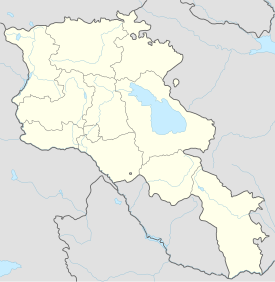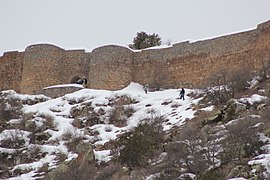
Vayots Dzor is a province (marz) of Armenia. It lies at the southeastern end of the country, bordering the Nakhchivan exclave of Azerbaijan to the west and the Kalbajar District of Azerbaijan to the east. It covers an area of 2,308 km2 (891 sq mi). With a population of only 52,324, it is the most sparsely populated province in the country. The capital and largest city of the province is the town of Yeghegnadzor.
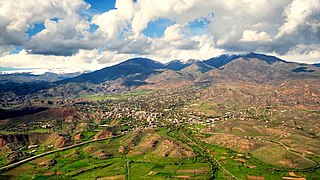
Yeghegnadzor is a town and urban municipal community in southern Armenia, serving as the provincial capital of Vayots Dzor Province and the Yeghegnadzor Municipality. It is located at a road distance of 123 km (76 mi) south of the capital Yerevan, on the shores of Srkghonk River, at a height of 1,194 meters (3,917 ft) above sea level.
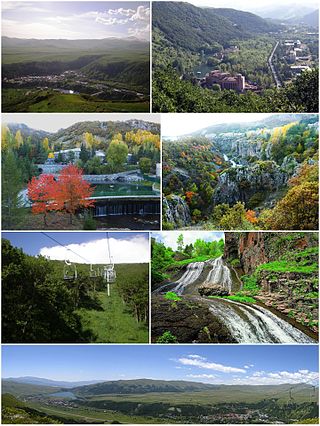
Jermuk is a mountain spa town and the centre of the Jermuk Municipality of the Vayots Dzor Province in southern Armenia, at a road distance of 53 km (33 mi) east of the provincial capital Yeghegnadzor. It was considered one of the popular destinations for medical tourism in the Soviet Union.
Momik was an Armenian architect, sculptor and a master artist of Armenian illuminated manuscripts. As a sculptor, Momik is also known for his fine carving of khachkars, found primarily at the monastery complex at Noravank. He held an eminent position at the Gladzor School of Illuminated Manuscripts in Syunik, established at Vayots Dzor under the patronage of the Orbelian family's historian, Stepanos Orbelian. Of the manuscripts authored by Momik, only several survive: one is found at the repository of the Mekhitarist Order in Vienna and three others are found at the Mashtots Institute of Ancient Manuscripts in Yerevan, Armenia.

The Orbelian Armenian lords of the province of Syunik were a noble family of Armenia, with a long history of political influence documented in inscriptions throughout the provinces of Vayots Dzor and Syunik, and recorded by the family historian Bishop Stepanos in his 1297 History of Syunik.

Berd is a town in the Tavush Province of Armenia. It is the administrative centre of Berd Municipality. The town is located to the west of the Tavush River, 211 kilometres from Yerevan, surrounded by low mountains. Near the city are the ruins of the 10th-century Tavush Fortress and the 12th-century monasteries Nor Varagavank and Khoranashat. Other monasteries nearby include Shkhmuradi, Srveghi, and Kaptavank. As of the 2022 census, the town had a population of 6,699, down from the 7,957 recorded in the 2011 census.

Haghartsin is a medieval monastery located near the town of Dilijan in the Tavush Province of Armenia. It was built between the 10th and 13th centuries. It is composed of three churches: St. Gregory's, St. Stephen's, and St. Astvatsatsin, as well as a gavit and a refectory.
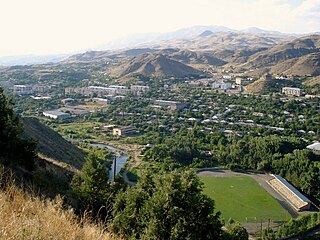
Vayk is a town and the centre of the Vayk Municipality of the Vayots Dzor Province of Armenia.

Artabuynk is a village in the Yeghegis Municipality of the Vayots Dzor Province of Armenia. The Smbataberd fortress is located near the village.

Azatek is a village in the Vayk Municipality of the Vayots Dzor Province of Armenia, on the left bank of the Arpa River.

Yeghegis is a village in the Yeghegis Municipality of the Vayots Dzor Province in Armenia. It has a rich historical past, with the medieval Zorats Church, the Tsakhats Kar Monastery and the Smbataberd fortress being located in the vicinity of Yeghegis, as well as a Jewish cemetery from the 13th century.

Proshaberd is a fortress built in the 13th century by Prince Prosh Khaghbakian. It is located about 7 kilometres (4 mi) northeast of the town of Vernashen in the Vayots Dzor Province of Armenia. It is located about one kilometre east of the 14th-century Spitakavor Monastery.
Alinja is a village and municipality in the Julfa District of Nakhchivan, Azerbaijan. The mausoleum and shrine of the Hurufi Fazlallah are located on a hillside overlooking the village. Qara Iskander, the ruler of Kara Koyunlu was murdered in the castle in 1437 by his son Shah Kubad.

Tsaghats Kar Monastery is an Armenian monastery located along the mountain foothills overlooking the Yeghegis River, between the villages of Yeghegis and Horbategh in the Vayots Dzor Province of Armenia. The monastery is located within walking distance of the fortress of Smbataberd.

The Bagratuni or Bagratid dynasty was an Armenian royal dynasty which ruled the medieval Kingdom of Armenia from c. 885 until 1045. Originating as vassals of the Kingdom of Armenia of antiquity, they rose to become the most prominent Armenian noble family during the period of Arab rule in Armenia, eventually establishing their own independent kingdom. Their domain included regions of Armenia such as Shirak, Bagrevand, Kogovit, Syunik, Lori, Vaspurakan, Vanand and Taron. Many historians, such as Cyril Toumanoff, Nicholas Adontz and Ronald Suny, consider them to be the progenitors of the Georgian royal Bagrationi dynasty.

Syunik was a region of historical Armenia and the ninth province of the Kingdom of Armenia from 189 BC until 428 AD. From the 7th to 9th centuries, it fell under Arab control. In 821, it formed two Armenian principalities: Kingdom of Syunik and principality of Khachen, which around the year 1000 was proclaimed the Kingdom of Artsakh, becoming one of the last medieval eastern Armenian kingdoms and principalities to maintain its autonomy following the Turkic invasions of the 11th to 14th centuries.
The Bagratuni family tree describes the heritage of the Bagratuni family in Armenia. Bagratuni lineage also lays claim to the Georgian Bagrationi dynasty.

Kingdom of Syunik, also known as the Kingdom of Baghk and sometimes as the Kingdom of Kapan, was a medieval dependent Armenian kingdom on the territory of Syunik, Artsakh, and Gegharkunik. Ruled by the Siunia dynasty, the town of Kapan was the capital of the kingdom. It existed from 987-1170. Kingdom of Syunik disappeared later than all other Armenian kingdoms in Greater Armenia.

Diocese of Vayots Dzor, is one of the newest dioceses of the Armenian Apostolic Church covering the Vayots Dzor Province of Armenia. The diocesan headquarters are located in the town of Yeghegnadzor. The seat of the bishop is the 12th-century Holy Mother of God Cathedral of Yeghegnadzor.
Moz in the province of Vayots Dzor was an ancient town in southern Armenia that was destroyed by an earthquake and volcanic eruption in the year of 735. It is the oldest historically documented settlement in Vayots Dzor. In the 7th to 8th centuries, the town was a significant trading and craft center on the Silk Road, with several thousand inhabitants. Moz was the main seat of the Armenian princes of Syunik from the House of Orbelian, who relocated it to Yeghegis after the destruction of the town.

